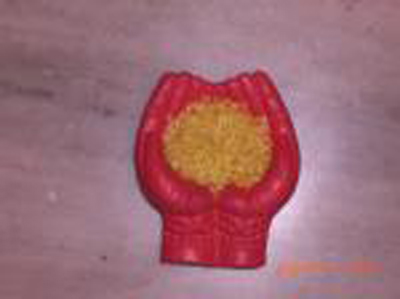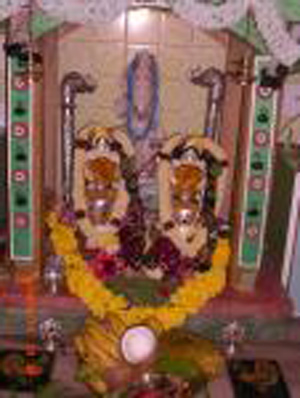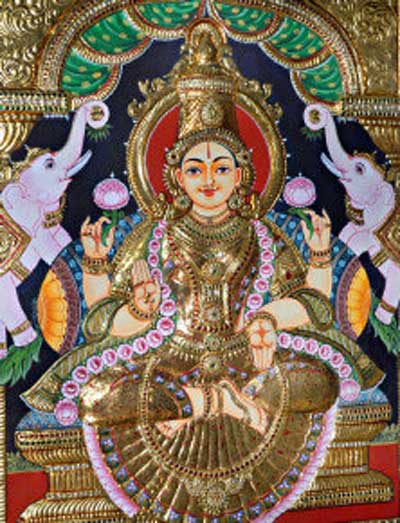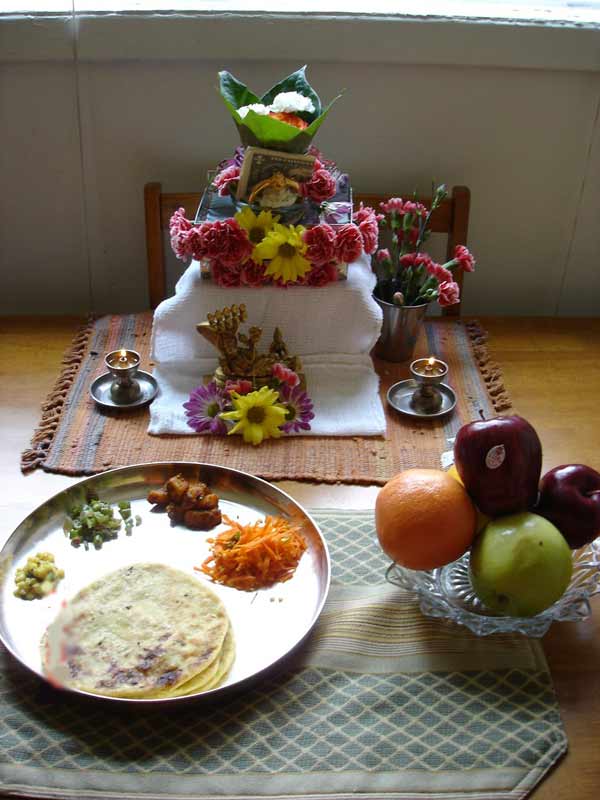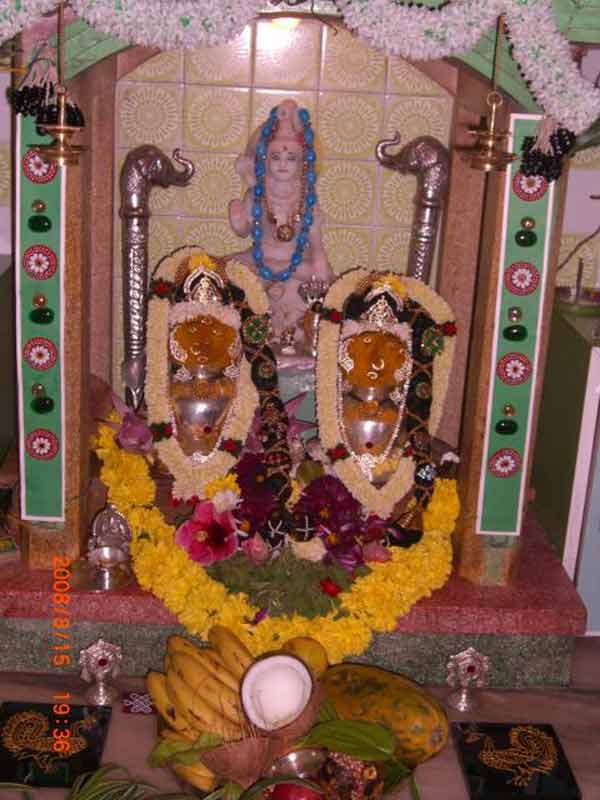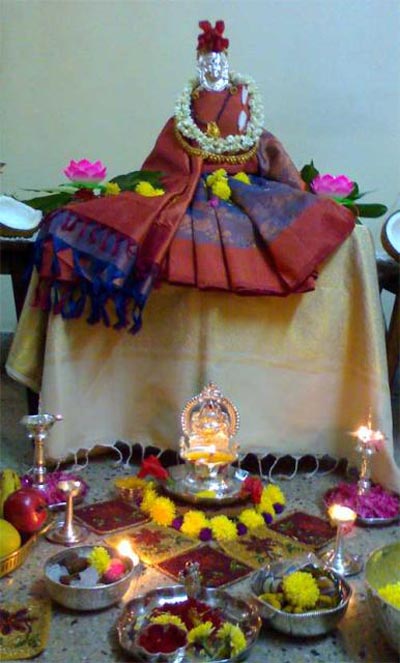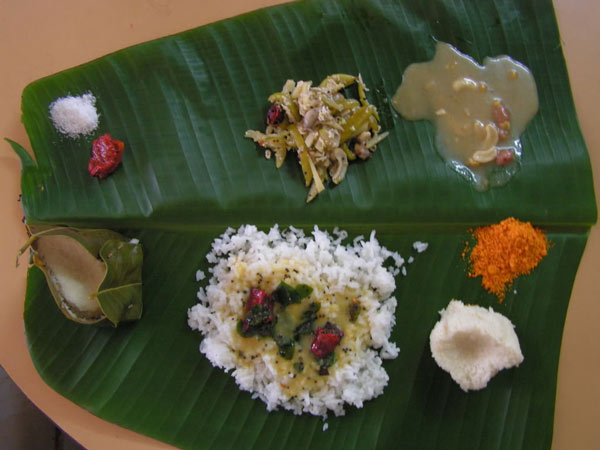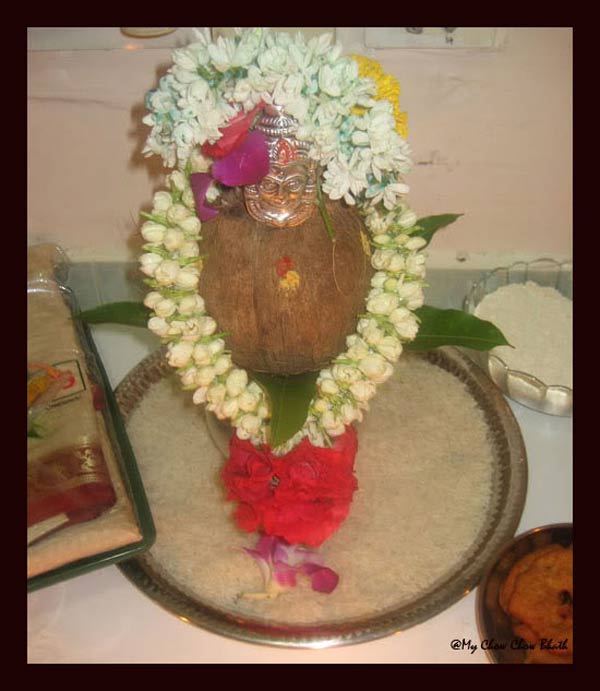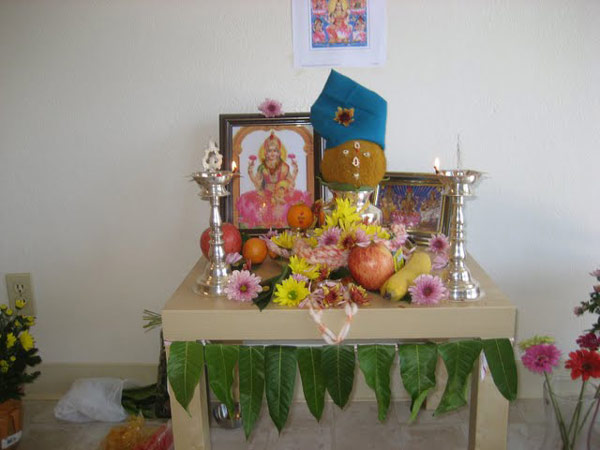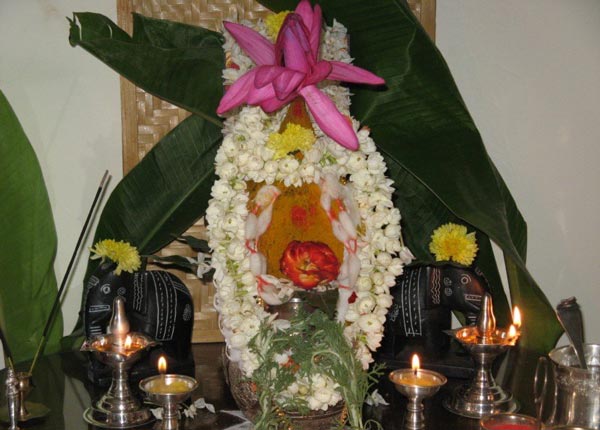Vara Mahalakshmi Festival
Vara Mahalakshmi-:Karnataka |
About: |
| We at Karnataka celebrate Varamahalakshmi vratha on second friday of Shravana masa before full moon day. It is an auspicious day to worship goddess Lakshmi on this day and pray for your loved one's longeivity, health and wealth.The goddess, called Devi, Ambal, Lakshmi, Shakthi, is one of the most important figures in the Hindu pantheon. Tradition tells us to pray to the Goddess first, because with her kind and benevolent heart, she will intercede with the Lord for the granting of any boon.
While the goddess represents everything from power to prosperity, in the form of Lakshmi, the consort of Lord Vishnu, she is a symbol of wealth. Visitors to the hill shrine of Tirupati, after offering worship at the sanctum sanctorum of Lord Srinivasa, circumambulate the shrine and then come to the figurine of Goddess Lakshmi set high up in the wall. She is in standing posture with gold coins pouring out of her hand. They reach up and touch her feet. Even children, too small to reach the image, are lifted up and the ritual is gone through. Vara Mahalakshmi In Karnataka, one of the most popular shrines .the winding steps take one-to-one manifestation of Lakshmi. It is said that Lakshmi will enter the house of anyone who thinks of her and bless them. There are many festivals in the year dedicated to Goddess Lakshmi. Among them, Varalakshmi Vratham is unique because it is marked by strict observance of certain practices and austerities. It is also called Varalakshmi Nonbu. The puja falls on Friday before the full moon in the Tamil month of Aadi. This year, it occurs on August 8th. The name Varalakshmi itself can be interpreted in two ways. In one sense, Varalakshmi is one who grants boons. In another, she is the Goddess who is invited into the home and honoured. The different types of benefits that will accrue thanks to performing the Varalakshmi puja are "dhan" (money), "dhanyam" (grains or food), "arogyam" (health), "sampath" (property), "sathsanthanam" virtuous offspring and "dheerga saumangalyam" longevity of the husb and Performing the Varalakshmi puja is said to be equivalent to worshipping all the different forms of Lakshmi. |
Location info: |
| Address:Karnataka,India |
| District: Karnataka,India |
| Celebrate Time:July to August |
Climate/Weather: |
| During winter temperatures range from 32 degrees Celsius to below 20 degrees Celsius,Summer Average temperature is 34 degrees Celsius |
History: |
| It was a special day for women as Varamahalakshmi puja was celebrated with the worship of "kalasha," and many neighbourhoods particularly the old areas of the city .Women attired in their best not only celebrated the festival in their homes, but also visited each other's houses for the traditional "Arishina-kumkuma" and "aarti" in the evening."Varamahalakshmi vratha" is celebrated to bring home the Goddess of Wealth and "ask her to stay all year, bringing prosperity and wealth and good fortune to the family". |
Importance: |
| Varalakshmi Nombu, or Vara Mahalakshmi Puja, is a popular Hindu ritual observed by married women in Karnataka . Married women worship Goddess Lakshmi on this day. In Tamil Nadu the festival takes place in the Aadi month of r and in Karnataka in the Shravan month of Kannada.It is believed that worshipping Goddess Lakshmi on this day gives the benefits of worshipping Ashta Lakshmi - the eight goddesses of Earth, Learning, Wealth, Love, Fame, Strength, Peace and Pleasure.Legend has it that Lord Shiva explained about the importance of Varalakshmi Nombu to Goddess Parvati, when the Goddess wanted to know about the most beneficial nombu or Vratam that married women should observe.
Shlokas dedicated to Goddess Lakshmi are recited, the idol of the goddess is decorated, a Kalash half-filled with rice and neck of the pot is decorated with fresh mango and betel leaves, a coconut smeared with haldi and kumkum and cloth are placed in the puja area and Goddess Lakshmi is invoked therein. Women fast till the puja is over. Special dishes like vada, mango rice, dal vadas and sweets like payasam are prepared on the day.Women gather in houses in the neighborhood and take part in community 'arathi' in the evening. They exchange gifts like bangles, kumkum, betel leaves, fruits and flowers. |
Method of Celebration: |
| Varalakshmi Pooja: This pooja falls on dwadasi as well as Friday in the month of Aadi or Aavani (Tamil month), the day in which goddess Lakshmi was born from the cosmic sea. Varalakshmi is the Goddess of wealth and gives us whatever we want. To get the blessing of Lakshmi, we perform this pooja with great care and devotion. This pooja is celebrated in a grand manner.
The pooja room is cleaned the previous day (Thursday) and floral decorations and kolam with rice flour should be done. After cleaning the sombu (kalasam), put some coins, betel, betel nut, turmeric, lemon, comb, mirror, black bangles (very small), black beads, raw rice, kunguma chimizh (very small one) inside it. Arrange the mango leaves over this and keep a coconut on top. Fix the amman face on the coconut, then decorate the kalasam with flowers. Place some flowers. Keep the sombu in the pooja, prepare ven pongal for neivedhyam. Have faith that Goddess Lakshmi Herself is residing in that Kalssam. Perform karpoora aarathi. yellow thread Pooja: aarati: |
Culture of Festivities: |
| The goddess, called Devi, Ambal, Lakshmi, Shakthi, is one of the most important figures in the Hindu pantheon. Tradition tells us to pray to the Goddess first, because with her kind and benevolent heart, she will intercede with the Lord for the granting of any boon. While the goddess represents everything from power to prosperity, in the form of Lakshmi, the consort of Lord Vishnu, she is a symbol of wealth.
The evening before the day of the puja, the area for its performance is cleaned and decorated. A bronze or silver kalasam (special pot) is filled with rice or water and coins, a whole lime, five types of leaves and betel leaves and betel nut. The kalasam is smeared with sandal paste and covered with a new cloth up to the neck. A coconut applied with turmeric paste is placed on top with mango leaves around. An image of the Goddess made of different materials, including cloth, is affixed to this. The kalasam is deemed to be the Goddess herself. Offerings of pongal are made and arathi is performed. The next morning, before rahu kalam, the kalasam is placed on a bed of rice. This signifies that Lakshmi has entered the house. After the installation, a puja beginning with an invocation to Lord Vinayaka begins. During the puja, the Lakshmi Sahasranamam and other slokas dedicated to Varalakshmi are chanted. Different types of sweets are offered to the Goddess. The women and girls of the house tie yellow coloured saradu or thread around their wrists. Thamboolam is given to other "sumangalis" (married women) who are invited to the house that evening. The woman who has performed the puja observes a fast on that day, eating only certain items. The following day the holy water in the kalasam is sprinkled throughout the house. If rice has been used in the place of water then it is mixed with the rice stored in the house. The legend behind Varalakshmi puja and the vratam is fascinating. It was a game of dice which caused a small tiff between Lord Shiva and Parvati as to who was the victor. An honest gana, Chitranemi, was asked to arbitrate and he decided in Shiva's favour. An angry Parvati cursed him to suffer from leprosy. When Shiva pleaded with her, she gave in and said the day women in the world observed Varalakshmi puja, Chitranemi would get deliverance. Chitranemi got relief when he observed some women performing the puja. Ever since then, this vratham has been observed. |




